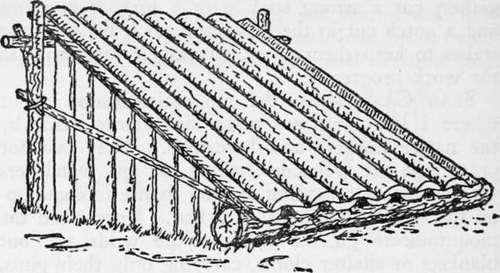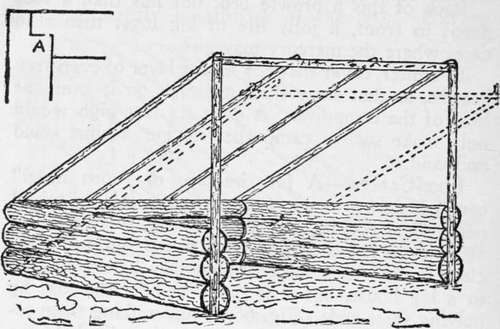Tomahawk Shelters. Axemen's Camps. Caches. Masked Camps. Part 4
Description
This section is from the book "Camping And Woodcraft", by Horace Kephart. Also available from Amazon: Camping and Woodcraft.
Tomahawk Shelters. Axemen's Camps. Caches. Masked Camps. Part 4
A slab camp may be made a very comfortable re* treat by taking a little more pains, and it will last unimpaired for years, providing ready-made quarters for future trips. Instead of plain slabs, which let in more or less rainwater, owing to imperfect joining at the laps, use "scoops." These are simply slabs wuth the flat side hollowed out into shallow troughs or gutters. This is done by cutting a series of cross hacks a few inches apart along the core of the slab from end to end, then, splitting these out by chopping lightly lengthwise of the slab. Having set up your ridge pole, roll a good sized log to form a back for the camp, about seven feet from the ridge, and peg it in position. Lay the scoops overlapping from ridge to log (Fig. 65) and nail them fast, or drive stakes at the rear against ends of scoops. Then enclose the sides with splits or bark, and chink crevices around the log with moss or clay.

Fig. 65. Slab Camp.
The siding may extend to the roof, being trimmed there to proper angle, or may rise little or no higher than the side bar shown in the illustration. The latter plan is best in localities where there are eddying and contrary winds, because it lets smoke out, instead of smoking out the occupants. It is the draught along the ground that chills sleepers, not what comes from above.
In a mountainous region it may be necessary to build the camp in a hollow between steep ridges. In that case, make it face across the hollow, not up nor down, because the night draughts sweep down a ravine and reverse currents draw up it.
To complete the slab camp, add side logs on the inside, and a foot-log for the bed, the latter being, say, fifteen inches thick, so as to serve as a "deacon's seat." The roof should project far enough in front to shelter the deacon and elders when they are busy holding down the aforesaid log.
Back of this a browse bed, not less than a foot deep; in front, a jolly fire of big logs: then who cares where the mercury may go?
In winter, cover the roof with a layer of evergreen boughs, so that snow shall not melt on it from the heat of the camp-fire. A drift six feet high would only make such a camp the snugger against wind and cold.
Log Camps
A favorite type of "open faced" camp, is shown in Fig. 66. Logs are laid on top of each other, at sides and rear of camp, to a height of about three feet, being flattened a little so as to make close joints. The back corners may be notched, as in a log house, but it is easier to butt the logs by halving their ends (Fig. 66.4) and spiking them together. Two stakes are set up in front to hold the ridge pole, and the front ends of the logs are spiked to them. As many rafters as needed are nailed to the ridge pole in front and the top log at the rear. The roof usually is of canvas, but bark or splits may be used by adding cross pieces to hold them. The triangular sides may be enclosed, or left open as smoke vents, bushy boughs being leaned up against the windward side when desired.
The stakes need not be set in the ground, but if it is preferred to do so, the stakes being of green timber, select such poles as are durable in the soil, and roast the sap out of their lower ends until the surface is charred, as this will help keep them from rotting.
In covering such a shelter, put on the siding first) and the roof last, so as to overlap. A two or three-foot overhang sloping downward from the ridge is a desirable addition, to keep rain from driving in. A simple and effective way to rig it is shown by the dotted lines, which represent two forked poles slanting upward from the rear, outside of logs, nailed to logs and posts, and a cross bar laid in the forks to hold the font edge of tarpaulin or whatever else is used as roof. The most comfortable open-air camps that I have made were of this design. There is much more room than in a simple lean-to of the same ground dimensions, and heat from the camp-fire is reflected down on the occupants so that they are comfortable in zero weather, yet they have the fresh air of all outdoors.

Fig. 66. Log and Frame Camp.
I prefer such quarters to any tent that ever was made. In summer, the front and sides are easily screened with mosquito netting, a pole on the ground holding the front curtain down. If a little care is used in selecting wood that is durable (see table in Chapter XII) such a camp will last for several seasons, the tarpaulin, of course, being carried along on each trip. For two men and their duffel, a good size is 7 feet high, 7 feet wide, and 9 feet deep, inside measurement; for more, merely increase the width.
An excellent camp for a party is arranged by building two such shelters, facing each other, with a log fire between, and a "kitchen" with dining table, benches, and "pantry," at one side, as shown in the ground plan (Fig. 67). The fire is built by laying logs on thick "hand junks," and throws out heat in all directions. In bad, windy weather, the end opposite the kitchen is screened by setting up a row of bushy evergreens close together.
Caches
In a camp that is liable to be raided by 'coons, porcupines, or other predatory animals, the meat, fish, butter, lard, etc., should be cached under piles of stones twice as heavy as you think such beasts could move, for they are astonishingly strong and persistent. Bears will demolish any such pile that one man could build.
To cache provisions and other articles in trees: Fasten a strong peeled pole from the fork of one tree to another at fifteen to twenty feet from the ground, wrap up the parcel in canvas or oilskin so snugly that ants cannot get into it, and suspend it from the pole with ropes or wires. The trees should be too slender for a bear to climb, yet too stout for him to shake. The pole is peeled to Ģive less secure footing for small animals, and to make it season into sound wood that will not rot and break. Canvas waterproofed with linseed oil is the best covering, as its odor and taste are offensive to animals of all kinds, great and small. A further pre-caution, in case of a light parcel, is to make a St. Andrew's cross (X-shaped), hang it from the pole, and suspend the package from the end of one arm of the cross, so that every puff of wind will set it swinging.
Continue to:
- prev: Tomahawk Shelters. Axemen's Camps. Caches. Masked Camps. Part 3
- Table of Contents
- next: Tomahawk Shelters. Axemen's Camps. Caches. Masked Camps. Part 5
